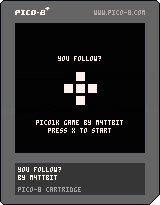INSTRUCTIONS
Follow me? See if you can keep up with this sequencing game of colors and sound. How much memory can you store? This game was made for the PICO1K Game Jam, where the goal is to create a PICO-8 game in under 1KB of compressed memory.
DEVLOG
For the 2023 PICO1K Game Jam, I decided to pay homage to the classic Simon electronic game - with a twist. A fifth square is added to the center of my game where an additional key/button is required to match the center color. The game jam requires that all entries must be less than or equal to 1024 (1K) compressed bytes of code. Only code can be used to create the game, tool, art, or interactive experience. Pre-defined PICO-8 data is not allowed, including pre-created sprites, map, sounds, or external files.
Developers had a month to work on their game jam entries. Over the course of five days during the month, I was able to develop this tiny game. I used an amazing PICO-8 compression visualizer tool, PXAVIZ, created by carlc27843. This slick tool let's you visually analyze the code that's easy to compress versus code bytes that are not reused often and can't be compressed. After my final iteration of developing the game, I was able to get my code for Follow Me? down to 971 compressed bytes. I'm sure there's more PICO-8 coding tricks that might compress it even more, but I met my goal for this fun game jam.
-- you follow?
-- by m4ttbit
l={8,12,11,10,9}
bt=true
function clr()
for z in all(s) do
z.show=false
end
n=true
end
function snd()
if en then
print '\abdf'
print '\aace'
else
for z in all(s) do
if z.show then
u=z.pos
if u==1 then
print '\ac'
elseif u==2 then
print '\ad'
elseif u==3 then
print '\ae'
elseif u==4 then
print '\af'
elseif u==5 then
print '\ag'
end
end
end
end
end
function rst()
i+=1
cl=1
n=false
end
function _init()
s={}
p={}
cl=1
st=7
t=1
id=1
n=true
en=false
comp=true
ad=false
for i=48,72,12 do
z={pos=t,x=i,y=60,a=i+8,b=68,c=7,oc=l[t],show=false}
add(s,z)
t+=1
end
for i=48,72,24 do
z={pos=t,x=60,y=i,a=68,b=i+8,c=7,oc=l[t],show=false}
add(s,z)
t+=1
end
end
function _update()
if en then
pt='game over'
pr='press x to play again'
if cl%30==0 then
clr()
else
cl+=1
end
if btn(5) then
_init()
end
elseif bt then
pt='you follow?'
tr='pico1k game by m4ttbit'
pr='press x to start'
if btn(5) then
bt=false
end
else
if cl%20==0 and comp and n then
pt='my turn'
tr='score: '..#p
pr=''
bt=false
if ad and i<=#p then
id=p[i]
s[id].show=true
snd()
i+=1
cl=1
n=false
else
rn=flr(rnd(5))+1
for z in all(s) do
if z.pos==rn then
z.show=true
snd()
add(p,z.pos)
n=false
i=1
cl=1
comp=false
end
end
end
end
if comp and n==false and cl%10==0 then
clr()
end
if comp==false and n then
pt='your turn'
if i>#p then
comp=true
cl=1
i=1
ad=true
else
if cl%100==0 then
en=true
snd()
end
if btnp(0) then
s[1].show=true
snd()
if p[i]==1 then
rst()
else
en=true
snd()
end
end
if btn(1) then
s[3].show=true
snd()
if p[i]==3 then
rst()
else
en=true
snd()
end
end
if btn(2) then
s[4].show=true
snd()
if p[i]==4 then
rst()
else
en=true
snd()
end
end
if btn(3) then
s[5].show=true
snd()
if p[i]==5 then
rst()
else
en=true
snd()
end
end
if btn(4) then
s[2].show=true
snd()
if p[i]==2 then
rst()
else
en=true
snd()
end
end
end
end
if comp==false and n==false and cl%10==0 then
clr()
end
cl+=1
end
end
function _draw()
cls()
for z in all(s) do
if z.show then
rectfill(z.x,z.y,z.a,z.b,z.oc)
else
rectfill(z.x,z.y,z.a,z.b,z.c)
end
end
print(pt,64-#pt*2,32,7)
print(tr,64-#tr*2,96,7)
print(pr,64-#pr*2,104,7)
end
